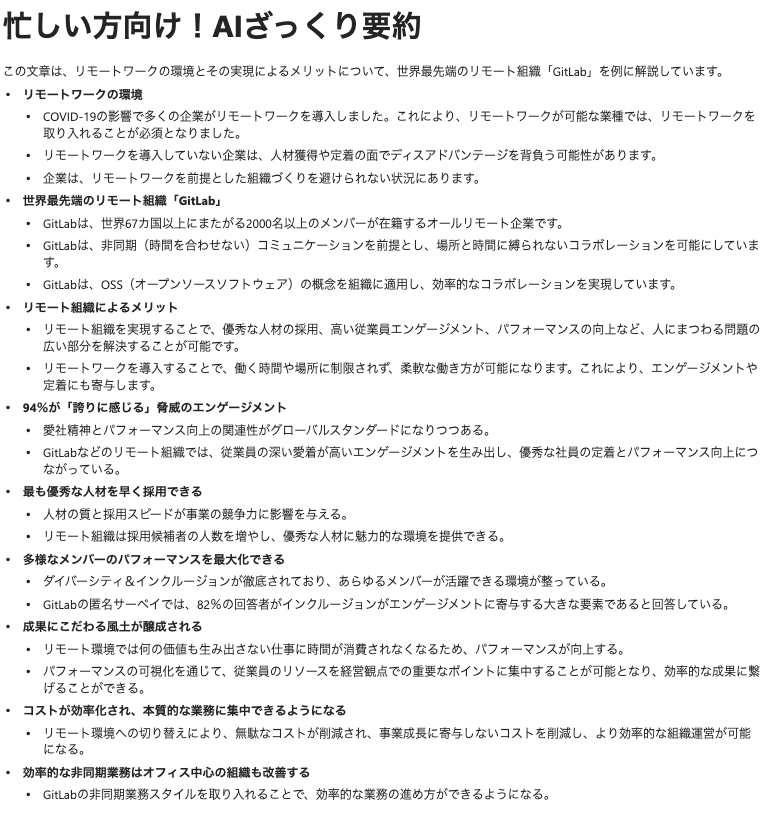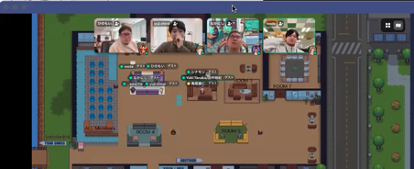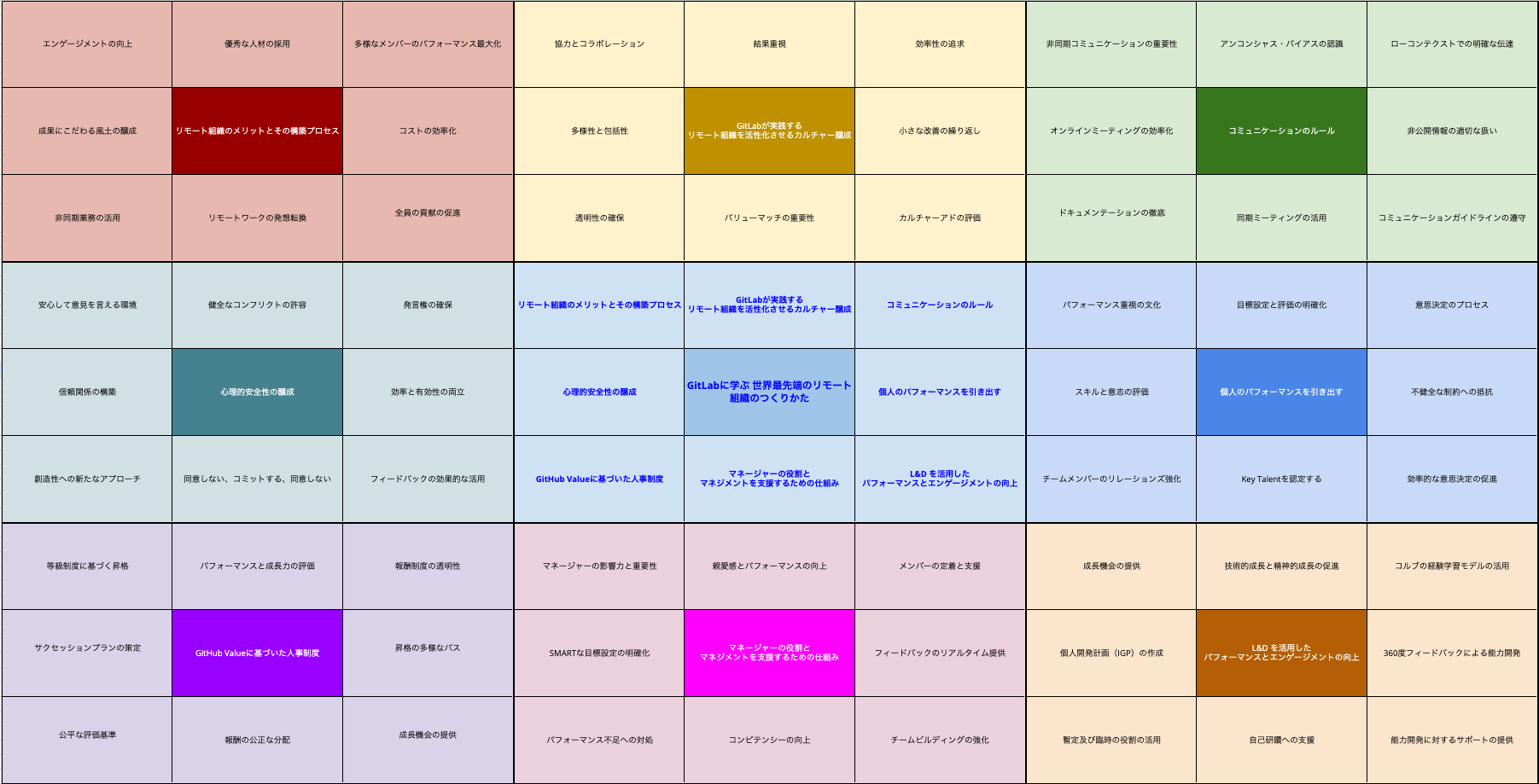「GitLabに学ぶ 世界最先端のリモート組織のつくりかた」輪読会が最高だったのでシェアしたい

「GitLabに学ぶ 世界最先端のリモート組織のつくりかた」輪読会が最高だったのでシェアしたい
こんにちは、あわっち(@_awache) です。
今回は「GitLabに学ぶ 世界最先端のリモート組織のつくりかた ドキュメントの活用でオフィスなしでも最大の成果を出すグローバル企業のしくみ」という本に魅せられ、輪読会を社内外を巻き込んだイベントにしている取り組みについて共有させていただきます。
告知: 「GitLabに学ぶ 世界最先端のリモート組織のつくりかた」そーだいなる輪読会 フィナーレ を開催します
いきなりの告知となりますが大切なことなので最初に書きます。
- Cnnpass: 「GitLabに学ぶ 世界最先端のリモート組織のつくりかた」そーだいなる輪読会 フィナーレ
- 開催日時: 2024-04-25(木) 18:00 ~ 21:00 (17:40 開場)
- 形式: オフライン
- 会場: KINTOテクノロジーズ株式会社(略称:KTC)室町オフィス
「GitLabに学ぶ 世界最先端のリモート組織のつくりかた ドキュメントの活用でオフィスなしでも最大の成果を出すグローバル企業のしくみ」の輪読会をすでにした方、現在進行形でしている方、そしてこれからしたい方向けの輪読会イベントとなっております。
実際に自分たちで輪読会をしてみてどんな形で輪読会をしたのか?実際反響どうだったのか?この本からどんな気づきを得られたのか?を参加者全員でディスカッションできる場として提供したいと考えています。
まだ枠に余裕がありますので興味ある方はぜひご参加ください!軽い気持ちで来ても楽しめるように工夫してみたいと考えています。
(リモート組織の話をオフラインでしようという矛盾には触れないでおいてください笑)
輪読会によくある課題
- 継続的な参加者の確保
- 本を一冊読み終えるためには定期的に集まる必要があります、週に 1回開催するとして適切な分量に分割すると2 ~3 ヶ月くらいは参加者の時間を確保する必要があります
- 途中フェードアウト
- 継続的に物事を進めることは非常に難しいです
- 会を重ねるごとに一人、また一人とフェードアウトしてしまうことは自然な流れです
- 参加者のモチベーションを繋ぎ止めることができなければ最後にはボッチ輪読会、みたいなことにもなりかねません
- 途中参加の難しさ
- 輪読会は本を読んでいくという特性上、途中参加のハードルが上がりやすいので人数は減ることはあっても増えることは非常に珍しい状況です
- リーダーシップの持続
- リードする人の負担は様々なところにあります
- 事前準備
- 参加者の時間の確保
- ファシリテーション
- これらは単発ではなくその輪読会が完了するまでずっと続きます
- 一人でやり続けるには相当なモチベーションが必要となります
- リードする人の負担は様々なところにあります
- 参加者の読書速度や理解度の違いを認識する
- 参加者によって読書のスピードや理解度は異なります、それを認識しないで輪読会を行うと議論が盛り上がらずに退屈な時間が過ぎることになります
などなど、本を一冊やり切ることってなんだかんだ難しいですよね。。。僕自身も途中でフェードアウトしたり最後までやりきれないで自然消滅させてしまったりしたことが何度もあります。
ただ、今回はどうしてもこの本の考え方を社内に広く共有したかったことと、最後までやり切りたいという思いが強かったこともあり、どうしたらこれらの課題を解決できるかを考えていました。
例えば、自分たちだけではなく企業の枠を超えて複数の場所で同じ題材で別々の方法で輪読会を実施し、最後に実施した内容をアウトプットするという機会を作ることで課題に対して効果的にアプローチできるのではないかという仮説を立ててみたたのですが、実現には僕だけでやるには限界があります。
そこで、弊社 DBRE チームで技術アドバイザーをしていただいている@soudai1025 さんに相談し、@soudai1025 さんの協力のもと「そーだいなる輪読会」という企画を始めることにしました。
そーだいなる輪読会の開催
そーだいなる輪読会は複数の企業が
- このキックオフをきっかけに
- 3ヶ月程度の時間を設けて輪読会を実施
- 最後にアウトプットをする
という三段構えのイベントです。
キックオフの様子は YouTube に上がっていますのでこちらもぜひご確認ください。
輪読会開催までの道のり
キックオフも終わり輪読会を開催するまでに僕が準備したことをざらっと記載してみます。
仲間集め
まずは社内のオープンチャンネルで仲間集めです。輪読会に興味がある方を把握し、手を挙げてくれる方を待ちます。結果として 14名の同志 を獲得しました!
写経 (本一冊分書き起こし)
輪読会をリードしていこうと決めた時から写経することの覚悟を決めていました。
読む → 書く→ 見直す、ということを一気にできる写経というアクションは書かれていることを短時間で理解するためには非常にいいアクティビティだと思っています。
ただし、この本は300ページ強、覚悟が必要です(笑)
書籍のまとめ購入
採用情報にも記載があるのですが、KINTOテクノロジーズは必要な書籍は会社で購入することができます。14名の同志の中でこの本を持っていない方が何名かいらっしゃったのでこの制度を利用し持っていない方の分をまとめ買いしました。
社内輪読会の進め方検討
みんなが負荷なく、いつ来てもそれなりに楽しむためにはどうしたらいいのか、それを考えて本気で悩みました。具体的なアクションは後ほど紹介しますね。
このようなことをしていたら気づいたら社内輪読会のキックオフが 2月になってしまいました。
社内輪読会キックオフ
Working Agreement
僕個人としてどんな輪読会の空気を作りたいか、をまとめたものを参加者の方々に共有しました。
以下がその内容です。
- 本輪読会は参加者の負荷を最小限に抑えることを考えて設計する
- 本を読んでこれなかったとしてもフォローし合う
- 最初の 10分間、黙々読書タイムを設ける
- ディスカッションをメインとし、そのアウトプットを公開することで実際に参加していないメンバーでも途中参加可能な空気を作る
- 毎回アウトプットをまとめて誰でも閲覧可能な状態にする
- (可能であれば) Zoom を録画し公開する
- 同じ内容を複数回やることも可能
- 参加者の自由な発言を妨げない
- 参加者の発言に共感できること、できないことがあることを受け入れる
- 自由なディスカッションを活性化させる
- ディスカッションは最大 4人のブレイクアウトルームで実施する
- 少人数でディスカッションを行うことで話すことの心理的ハードルを下げ、それぞれが話したい内容を話せる状態を作るる
- ROM (Read Only Member) 参加を拒絶しない
- 状況を理解するために意思を参加メンバーに伝える
- 今日はちょっと話せない
- 周りの環境で話しづらい
- 状況を理解するために意思を参加メンバーに伝える
- ディスカッションは最大 4人のブレイクアウトルームで実施する
- アウトプットは全員で積極的に作る
- ディスカッション内容の議事録などは手が空いている人 (発言していない人など) が積極的にログとして残す
輪読会の進め方
継続的なディスカッションを行うにはやはり一定のタイムラインがあることが望ましいと考えています。
ちょっと遅れたけど輪読会に途中から入りたい、と思っても白熱したディスカッションを行なっている時間帯だったら心理的に入ることが難しいかもしれません。
逆に今何をしているのか、ある程度わかっていれば、例えば今黙々読書タイムだから途中から入っても大丈夫、となる可能性もあります。
そのため型をバシッと決めました。
- 基本設計
- 黙々読書タイム (10分)
- ディスカッションタイム (30分)
- 内容共有 (20分)
- ディスカッション内容
- 共感したこと
- 共感できなかったこと
- KTC で実際に実践してみたいこと
- 次の回で実践した結果を共有してもいいかもしれない
- ディスカッション内容アウトプット
- ディスカッション中の議事は Google Slide を用意するのでそこに記載
- ディスカッションタイム終了後に全員でチームの内容を共有し合う
使用するツールの選定
-
Gather
Webミーティングツールとしては Gather を選択しました。
僕たちはディスカッションをメインとしたため、参加している人たちが気軽に話し合える人数で話していくことを考えていました。Zoom だと毎回ブレイクアウトルームを作らないといけないですし振り分けるのも大変です。
バーチャルオフィス空間である Gatherであれば、全員で集まる、少人数の部屋に移動してディスカッションができる、という自分たちのニーズにバッチリ合いました。
ただし、録画を共有する、ということには不向きなのでそこは諦めました。
代わりにしっかりとログを残して後からでも見直せるようにすることを徹底しました。 -
Microsoft Loop
コラボレーションには Loop を選択しました。KINTOテクノロジーズは基本的に Confluenceを使用しているのですが参加者が自由にメモを書き、共同編集を行うということに対しては少し弱かったので色々と考えた結果 Confluenceと体験がそれほど変わらない、けど共同編集のストレスが少ないという理由でこちらを採用です。
おかわりの会の設定
輪読会の時間は毎週火曜日の 18:00 ~ 19:00 に設定しました。ただ、この時間だとちょっと遅いですし、突発の業務都合が入ったり、お子さんがいたりする方にとってはゴールデンタイムと重なったりすることがあります。
そんな時に一度でも参加を逃してしまうと再参加の心理的ハードルが高くなってしまいます。なので僕は翌日の水曜日、12:00 ~ 13:00 で全く同じ内容を実施することを決めました。
これによって参加逃しのリスクを下げることができますし、前日に参加してくださった方でもより深く内容を理解する時間が持てるだけでなく、別の参加者の話を聞くことで新しい視点を持てて毎回楽しく参加することができました。
生成 AI の活用
上記の Working Agreement にも書いたのですが、僕自身本を読んでこなくてもフォローし合える場を作りたい思いが強かったです。最初の 10分間で黙々タイムを設けると言っても 10分間で必要な分量を読み切ることは割と難しいです。
そこで強い味方になってくれたのが写経と ChatGPT です。写経した文字列を必要な分だけ ChatGPT で要約をすることでたとえ10分間の黙々タイムでも参加者のインプットの質は大きく変わることを実感しました。
例えば第1部を要約するとこんな感じです。およそ 12ページがこの量になると黙々タイムも効果的だと思いませんか?

元の文章も Confluence にはあるので要約の中で気になったところがあったらキーワードを検索するとすぐにそのポイントを見つけることもできます。
個人的にはこれがあったからこそ最後まで走りきれたんだと思っているくらい重要な要素でした。
社内輪読会

結果として全部で 17回の輪読会を開催しました。17回も行なった中で最後までぼっちにならずにやり切ることができました(笑)
毎回参加してくださる方もいましたし、ご自身の都合で来れる時に来ていただく、という方もいました。おかわりがあることで 1回当たりの参加人数のばらつきがあったとしても、一章あたりの参加という点ではなかなかいい数字な気がしています。
-
第1部 リモート組織のメリットを読み解く / 第2部 世界最先端のリモート組織並行するためのプロセス
- 2024-02-13 (6名)
- 2024-02-14 (9名)
-
第5章 カルチャーはバリューによって醸成される
- 2024-02-21 (8名)
- 2024-02-27 (4名)
- 2024-02-28 (4名)
-
第6章 コミュニケーションのルール
- 2024-03-05 (7名)
- 2024-03-06 (5名)
-
第7章 リモート組織におけるオンボーディングの重要性 / 第8章 心理的安全性の醸成
- 2024-03-13 (7名)
- 2024-03-19 (5名)
-
第9章 個人のパフォーマンスを引き出す/第10章 GitHub Value に基づいた人事制度
- 2024-03-26 (7名)
- 2024-03-27 (5名)
-
第11章 マネージャーの役割とマネジメントを支援するための仕組み & 第12章 コンディショニングを実現する
- 2024-04-02 (6名)
- 2024-04-03 (7名)
-
第13章 L&D を活用してパフォーマンスとエンゲージメントを向上させる & おわりに
- 2024-04-09 (7名)
- 2024-04-10 (5名)
-
wrap up!
- 2024-04-16 (5名)
- 2024-04-17 (4名)
どんなことを話したのか、についてはぜひ「GitLabに学ぶ 世界最先端のリモート組織のつくりかた」そーだいなる輪読会 フィナーレに参加して聞いてみてください!
というのもやはりこの本は自分たちからみたら目指すべき姿が多く書かれており、現実との GAP についてどう考えているのか、という少し記事にしづらい生臭い議論がたくさんあったので、そこは当日お話しさせてください。
この輪読会を通じて得たもの/アウトプットしたもの
-
仲間
この輪読会に参加くださったことで初めて話した方も何人かいました、またこの輪読会を通じて参加くださった方々の思考も知ることができましたし、これからもこの繋がりを大切にしながら KINTOテクノロジーズを盛り上げていこうと思います。
弊社にはオープンに感謝を言い合える #thanks というチャンネルがあります。輪読会が終わった日に参加くださった方から温かい言葉をいただけたのも非常に嬉しかったです。

-
写経
これがあったから AI 要約だったり、輪読会のディスカッションの中で出た様々な話にも対応できたりしたので今後も輪読会をリードして行こうと思ったら重要なプロセスだと感じています。 -
AI 要約
生成 AI を活用して出力した要約はやはり強力です。どこに何が書いてあったか、時間の経過とともに忘れてしまうこともあるかもしれないですが、要約があればさらっと 10分眺めるだけで記憶が呼び戻されます。 -
マンダラチャート
自分なりにこの本のポイントをマンダラチャート方式でまとめてみました。もちろん全部やるなんて無理なのでポイントとテーマを決めて少しづつ自分のできることを増やしていきたいです。

おわりに
僕たちが行なった「GitLabに学ぶ 世界最先端のリモート組織のつくりかた ドキュメントの活用でオフィスなしでも最大の成果を出すグローバル企業のしくみ」の輪読会の様子はいかがでしたでしょうか?
個人的にはこれまで自分で行なってきたどの輪読会よりも満足度が高かったのでシェアをしたい気持ちが強くなったのでテックブログに書き起こさせていただきました。
本当はまだまだ書きたいこともあるのですが長くなりすぎるので一旦ここまでにします。
再告知: 「GitLabに学ぶ 世界最先端のリモート組織のつくりかた」そーだいなる輪読会 フィナーレ を開催します
まだ枠が余っています。僕たちも楽しい会にできるように頑張りますので、来てもいいという方はぜひご応募ください、切実にお願いします。
- Cnnpass: 「GitLabに学ぶ 世界最先端のリモート組織のつくりかた」そーだいなる輪読会 フィナーレ
- 開催日時: 2024-04-25(木) 18:00 ~ 21:00 (17:40 開場)
- 形式: オフライン
- 会場: KINTOテクノロジーズ株式会社(略称:KTC)室町オフィス
「GitLabに学ぶ 世界最先端のリモート組織のつくりかた ドキュメントの活用でオフィスなしでも最大の成果を出すグローバル企業のしくみ」の輪読会をすでにした方、現在進行形でしている方、そしてこれからしたい方向けの輪読会イベントとなっております。
イベントでもお会いできることを楽しみにしております♪
それでは!!
関連記事 | Related Posts

Preparations for Our First KINTO Technologies MeetUp! – Leading Up to the Event
![Cover Image for [Learning Roadside Station Podcast] General Managers MoM Reading Session](/assets/blog/authors/aoi.nakanishi/2024-12-podcast/minutes.jpg)
[Learning Roadside Station Podcast] General Managers MoM Reading Session

I experienced the futuristic reading method: Active Book Dialogue®

「GitLabに学ぶ 世界最先端のリモート組織のつくりかた」輪読会が最高だったのでシェアしたい

Destination: Learning! We started the Manabi-no-Michi-no-Eki

Learning Roadside Station: We Popped into the iOS Team's Study Session
We are hiring!
【クラウドエンジニア(クラウド活用の推進)】Cloud Infrastructure G/東京・大阪・福岡
KINTO Tech BlogCloud InfrastructureグループについてAWSを主としたクラウドインフラの設計、構築、運用を主に担当しています。
【ソフトウェアエンジニア(リーダークラス)】共通サービス開発G/東京・大阪・福岡
共通サービス開発グループについてWebサービスやモバイルアプリの開発において、必要となる共通機能=会員プラットフォームや決済プラットフォームなどの企画・開発を手がけるグループです。KINTOの名前が付くサービスやKINTOに関わりのあるサービスを同一のユーザーアカウントに対して提供し、より良いユーザー体験を実現できるよう、様々な共通機能や顧客基盤を構築していくことを目的としています。
